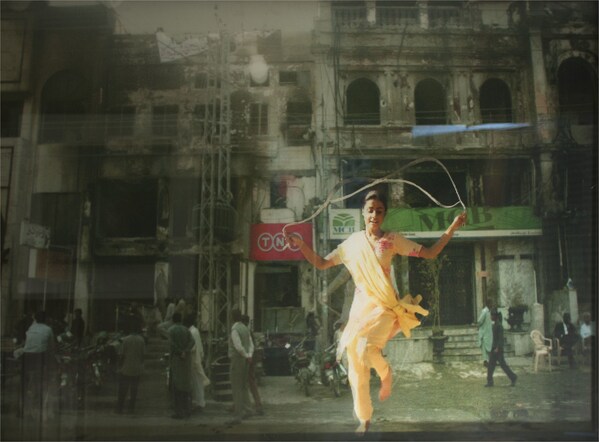DOHA, Qatar, Nov. 6, 2024 /PRNewswire/ -- Qatar Museums opened a first-of-its-kind exhibition exploring arts and architecture from Pakistan since the 1940s.

Farida Batool, Nai Reesan Shehr Lahore Diyan (2006), Lenticular Print, 81 x 162 cm, Naazish Ata-Ullah Collection, Courtesy of the Artist.
On view through January 31, 2025, MANZAR: Art and Architecture from Pakistan 1940s to Today brings together more than 200 artworks—paintings, drawings, photographs, videos, sculptures, installations, tapestries and miniatures, plus commissioned works by artists and architects currently living and working in Pakistan and its diasporas—to present various views of the country's artistic and architectural movements.
The Amir His Highness Sheikh Tamim bin Hamad Al Thani, Her Excellency Sheikha Al Mayassa bint Hamad bin Khalifa Al Thani, Chairperson of Qatar Museums, His Excellency Muhammad Shahbaz Sharif, and Prime Minister of the Islamic Republic of Pakistan, inaugurated the exhibition, alongside Catherine Grenier, Director of Concept of the Art Mill Museum and the curatorial team.
Organised by the future Art Mill Museum and presented in collaboration with the National Museum of Qatar, MANZAR presents the diverse output of the artists, architects, and others who have defined the narratives, histories, and contemporary perspectives of Pakistan's cultures over the past eighty years.
Through twelve themed galleries, the exhibition includes unprecedented loans from public Pakistani institutions such as the Alhamra Art Museum in Lahore and Pakistan National Council of the Arts in Islamabad; loans from private collections across Pakistan and in Dubai, London and New York; and works from Qatar Museums collections.
MANZAR is an Urdu and Arabic word meaning scene, view, landscape, or perspective. The exhibition begins with artists such as Abdur Rahman Chughtai and Zainul Abedin, who worked during the British Raj, and continued their practices in what became West and East Pakistan. The Partition of 1947 was—and still is—a major subject for artists such as Anna Molka Ahmed, Zarina and Bani Abidi. Organised loosely chronologically, the exhibition moves into aesthetic experiments by artists including Shakir Ali, Zubeida Agha, Murtaja Baseer and Sadequain, who developed highly personal modes of expression in urban centres including Karachi, Lahore, Dhaka and the twin cities of Rawalpindi and Islamabad.
Special attention is given to architects who transformed the country's landscape and articulated the ambitions of its institutions through major building projects. The first phase of development involved the expertise of many modern Western architects, such as the French Michel Ecochard, who built the first university in Karachi; Konstantínos Doxiádis from Greece, who was in charge of planning the future capital Islamabad; and architects from US who contributed to the establishment of the nation-state's institutions, such as Louis Kahn, Richard Neutra and Edward Durell Stone.
MANZAR then focuses on Pakistan's role in the debate on regionalism in architecture, with the backdrop of the Aga Khan Award for Architecture, held for the first time in Lahore in 1980. The works of major architects such as Nayyar Ali Dada and Kamil Khan Mumtaz from Lahore and Yasmeen Lari, Habib Fida Ali and Arif Hasan from Karachi will be presented in the context of this intellectual explosion.
Among the highlights by visual artists are works by Zahoor ul Akhlaq, Imran Mir and Rasheed Araeen, whose multidisciplinary approaches, involvement in educational initiatives, and theoretical writings challenged Western art history and traditions at home and internationally. Influential figures of different generations, such as Salima Hashmi, Quddus Mirza, Lala Rukh, Durriya Kazi, are represented. Alongside them are Rashid Rana, Imran Qureshi, Risham Syed and Hamra Abbas, who are known as key educators at the National College of Art and Beaconhouse National University in Lahore; and at Karachi University and Indus Valley School of Art and Architecture in Karachi.
This exhibition marks a significant development in Qatar's cultural landscape, bringing to light lesser-known global art histories and demonstrating how they weave into broader social and cultural trends. The themes explored range from nation-building and regionalism to the politics of land and water, emphasising the connection between Pakistan's cultural heritage and contemporary practices. The exhibition hopes to connect with and pay tribute to the many communities in Qatar who have origins in this part of the world and act as a bridge between different cultures.
The exhibition is curated by Caroline Hancock, Art Mill Museum Senior Curator of Modern and Contemporary Art; Aurélien Lemonier, Art Mill Museum Curator of Architecture, Design and Gardens; and Zarmeene Shah, independent curator, writer and Director of Graduate Studies at the Indus Valley School of Art and Architecture in Karachi.
A 312-page exhibition catalogue (featuring 500+ illustrations and designed by Kiran Ahmad) is published by the future Art Mill Museum. It includes essays by major art and architectural historians, educators and artists and architects from Pakistan and beyond. A vibrant public programme featuring performances, talks, screenings and other events will accompany the exhibition. Members of the public can view newly commissioned indoor and outdoor installations and explore contemporary projects which are centred around sustainability and ecologies.
The exhibition is presented as part of the Fall/Winter 2024-2025 Season of Qatar Creates, a platform dedicated to amplifying the voices of Qatar's creative industries and promoting cultural activities within the country.
For more information, visit: nmoq.org.qa/en/calendar/manzar-exhibition/.
source: Qatar Museums
《說說心理話》青少年自殺率上升,如何分辨求助訊號?社工分享陪伴的重要性► 即睇






























